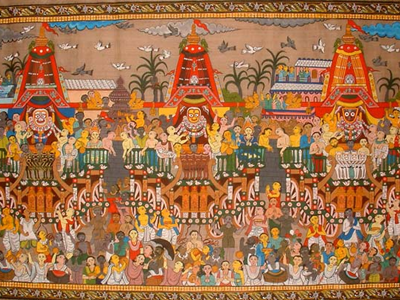Find out more about how this website uses cookies to enhance your browsing experience.
Significance
On the auspicious day of Ashadh Sud 2 (late June- early July), Devotees in the Sanatan Dhrama celebrate the Rath Yatra festival. Rath means chariot and Yatra - a pilgrimage or procession. It is celebrated all over India and originated in Jagannath Puri, located on the eastern coast of the country.
Three deities, Lord Krishna (Jagannath), Balaram and Devi Subhadra are traditionally installed on huge chariots and Devotees pull the chariots in a procession through the streets. The pathway of the chariots is usually swept by the local King.
On many occasions the Lord has embarked on journeys with His Devotees on chariots. One such occasion in particular is mostly celebrated as Rath Yatra. Lord Krishna, accompanied by Balaram, took Subhadra in for a ride in a chariot through the streets of Dwarika to show the city’s splendor. Sage Narad once saw the Lord together with Balram and Subhadra standing motionless listening to Krishna’s pastimes. He then requested that they grant such sight forever. Lord fulfilled His devotee’s wishes.
Further pastimes of Lord Jagannath can be read from the Skanda Puran authored by Ved Vyasji.
This Puran narrates about King Indradyumna’s quest to find a deity form of Lord Shree Krishna after dreaming of an elegant blue deity form of Nila-Madhava. This describes the sapphire hue of the deity - Nila means blue, and Madhava is one of Lord Krishna’s names. An expedition was carried out by King in search of Nila Madhava and a Bhramin named Vidyapati emerged successful. The King was informed that a pig farmer by the name of Vishvavasu was secretly worshiping Nila Madhava. The King and Vidyapati both made their way there but discovered that the deity was gone. The whole village was surrounded by the Kings soldiers who arrested Vishvavasu. A voice from the sky proclaimed to release Vishvavasu and build a big temple for the deity of a hill and Nila Madhava will be seen as a form of neem wood.
King Indradyumna built the temple and waited by the ocean, a giant log arrived floating towards the beach. Vishvakarma (Demi-God Architect) came disguised as an old man arrived to carve the log into a deity form under the condition that the task would be done behind locked doors and no one would be allowed entry before the final finish. The King’s curiosity good the better of him and before the due finish he opened the doors. Vishvakarma disappeared. Jagannath, Baladev, and Subhadra; the three forms carved were unfinished and without hands or feet. The King was greatly disappointed and blamed himself of offending the Lord. The King decided to give up his life by fasting. Lord Jagannath appeared before him and gave him reassurance that it is out of His own inconceivable desire that He wished to appear in such a way.
Life is a Rath Yatra
Our life is regarded as a Yatra – pilgrimage back to God. Our body symbolises the Rath – chariot with which we make the journey. Though on this chariot our Scriptures and Sages advise us to surrender all its control to the Supreme Lord and His men hence we should obey their commandments in order to make our journey back to Godhead a success. The Katopanishad / Katha Upanishad further elaborates on the above concept in the conversation between Yamraj and Nachiketa


